| Weight | 1 lbs |
|---|---|
| Dimensions | 9 × 5 × 2 in |
| host | mouse |
| isotype | IgG1 |
| clonality | monoclonal |
| concentration | concentrate, predilute |
| applications | IHC |
| reactivity | human |
| available size | 0.1 mL, 0.5 mL, 1 mL concentrated, 7 mL prediluted |
mouse anti-CD71 monoclonal antibody (ZM136) 6111
Price range: $160.00 through $528.00
Antibody summary
- Mouse monoclonal to CD71
- Suitable for: Immunohistochemistry (formalin-fixed, paraffin-embedded tissues)
- Reacts with: Human
- Isotype:IgG1
- Control: Bone marrow
- Visualization: Cytoplasmic
- 0.1, 0.5, 1.0 mL concentrated, 7 mL prediluted
mouse anti-CD71 monoclonal antibody ZM136 6111
| target relevance |
|---|
| Protein names Transferrin receptor protein 1 (TR) (TfR) (TfR1) (Trfr) (T9) (p90) (CD antigen CD71) [Cleaved into: Transferrin receptor protein 1, serum form (sTfR)] |
| Gene names TFRC,TFRC |
| Protein family Peptidase M28 family, M28B subfamily |
| Mass 84871Da |
| Function FUNCTION: Cellular uptake of iron occurs via receptor-mediated endocytosis of ligand-occupied transferrin receptor into specialized endosomes (PubMed:26214738). Endosomal acidification leads to iron release. The apotransferrin-receptor complex is then recycled to the cell surface with a return to neutral pH and the concomitant loss of affinity of apotransferrin for its receptor. Transferrin receptor is necessary for development of erythrocytes and the nervous system (By similarity). A second ligand, the hereditary hemochromatosis protein HFE, competes for binding with transferrin for an overlapping C-terminal binding site. Positively regulates T and B cell proliferation through iron uptake (PubMed:26642240). Acts as a lipid sensor that regulates mitochondrial fusion by regulating activation of the JNK pathway (PubMed:26214738). When dietary levels of stearate (C18:0) are low, promotes activation of the JNK pathway, resulting in HUWE1-mediated ubiquitination and subsequent degradation of the mitofusin MFN2 and inhibition of mitochondrial fusion (PubMed:26214738). When dietary levels of stearate (C18:0) are high, TFRC stearoylation inhibits activation of the JNK pathway and thus degradation of the mitofusin MFN2 (PubMed:26214738). Mediates uptake of NICOL1 into fibroblasts where it may regulate extracellular matrix production (By similarity). {ECO:0000250|UniProtKB:Q62351, ECO:0000269|PubMed:26214738, ECO:0000269|PubMed:26642240, ECO:0000269|PubMed:3568132}.; FUNCTION: (Microbial infection) Acts as a receptor for new-world arenaviruses: Guanarito, Junin and Machupo virus. {ECO:0000269|PubMed:17287727, ECO:0000269|PubMed:18268337}.; FUNCTION: (Microbial infection) Acts as a host entry factor for rabies virus that hijacks the endocytosis of TFRC to enter cells. {ECO:0000269|PubMed:36779762, ECO:0000269|PubMed:36779763}.; FUNCTION: (Microbial infection) Acts as a host entry factor for SARS-CoV, MERS-CoV and SARS-CoV-2 viruses that hijack the endocytosis of TFRC to enter cells. {ECO:0000269|PubMed:36779762}. |
| Subellular location SUBCELLULAR LOCATION: Cell membrane {ECO:0000269|PubMed:17081065}; Single-pass type II membrane protein {ECO:0000269|PubMed:17081065}. Melanosome {ECO:0000269|PubMed:17081065}. Note=Identified by mass spectrometry in melanosome fractions from stage I to stage IV. {ECO:0000269|PubMed:17081065}.; SUBCELLULAR LOCATION: [Transferrin receptor protein 1, serum form]: Secreted {ECO:0000269|PubMed:17081065}. |
| Structure SUBUNIT: Homodimer; disulfide-linked. Binds one transferrin or HFE molecule per subunit. Binds the HLA class II histocompatibility antigen, DR1. Interacts with SH3BP3. Interacts with STEAP3; facilitates TFRC endocytosis in erythroid precursor cells (PubMed:26642240). Interacts with GRM2 (PubMed:36779763). {ECO:0000269|PubMed:16325581, ECO:0000269|PubMed:26642240, ECO:0000269|PubMed:36779763}.; SUBUNIT: (Microbial infection) Interacts with Guanarito, Junin and Machupo arenavirus glycoprotein complex (PubMed:17287727, PubMed:18268337). {ECO:0000269|PubMed:17287727, ECO:0000269|PubMed:18268337}.; SUBUNIT: (Microbial infection) Interacts with rabies virus protein G. {ECO:0000269|PubMed:36779762, ECO:0000269|PubMed:36779763}.; SUBUNIT: (Microbial infection) Interacts with SARS-CoV-2 spike protein S. {ECO:0000269|PubMed:36779762, ECO:0000269|PubMed:36779763}. |
| Post-translational modification PTM: Stearoylated by ZDHHC6 which inhibits TFRC-mediated activation of the JNK pathway and promotes mitochondrial fragmentation (PubMed:26214738). Stearoylation does not affect iron uptake (PubMed:26214738). {ECO:0000269|PubMed:26214738}.; PTM: N- and O-glycosylated, phosphorylated and palmitoylated. The serum form is only glycosylated. {ECO:0000269|PubMed:1421756, ECO:0000269|PubMed:1421757, ECO:0000269|PubMed:16335952, ECO:0000269|PubMed:19159218, ECO:0000269|PubMed:19349973, ECO:0000269|PubMed:3582362}.; PTM: Proteolytically cleaved on Arg-100 to produce the soluble serum form (sTfR).; PTM: Palmitoylated on both Cys-62 and Cys-67. Cys-62 seems to be the major site of palmitoylation. {ECO:0000269|PubMed:3582362}. |
| Involvement in disease DISEASE: Immunodeficiency 46 (IMD46) [MIM:616740]: An autosomal recessive primary immunodeficiency disorder characterized by early-onset chronic diarrhea, recurrent infections, hypo- or agammaglobulinemia, normal lymphocyte counts, intermittent neutropenia, and intermittent thrombocytopenia. {ECO:0000269|PubMed:26642240}. Note=The disease is caused by variants affecting the gene represented in this entry. |
| Target Relevance information above includes information from UniProt accession: P02786 |
| The UniProt Consortium |
Data
 |
| Formalin-fixed, paraffin-embedded bone marrow stained with anti-CD71 antibody using peroxidase-conjugated and DAB chromogen. Note the cytoplasmic staining of erythroid precursors |
Publications
| pmid | title | authors | citation |
|---|---|---|---|
| We haven't added any publications to our database yet. | |||
Protocols
| relevant to this product |
|---|
| IHC |
Documents
| # | SDS | Certificate | |
|---|---|---|---|
| Please enter your product and batch number here to retrieve product datasheet, SDS, and QC information. | |||
Only logged in customers who have purchased this product may leave a review.



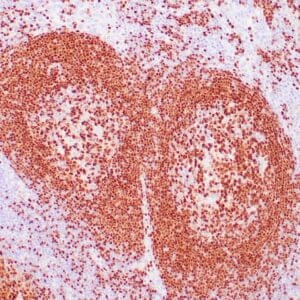
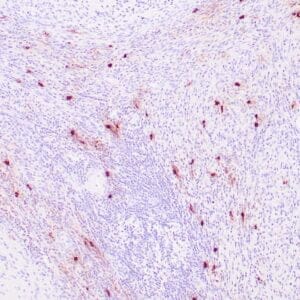
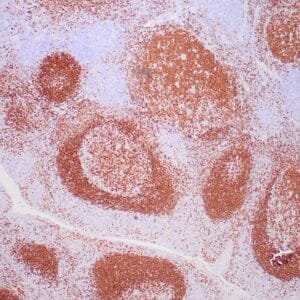


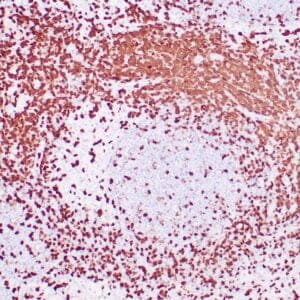

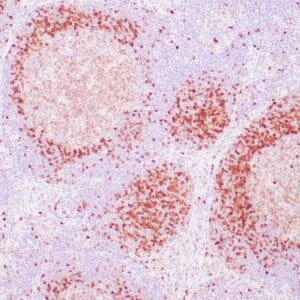

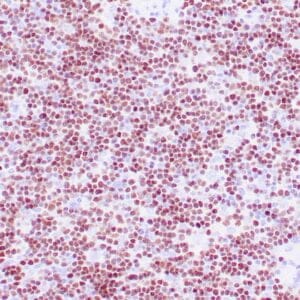
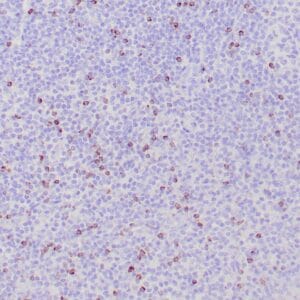
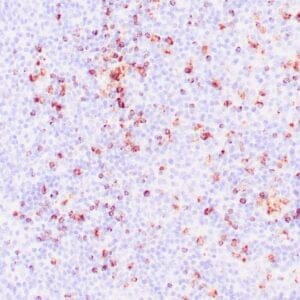
Reviews
There are no reviews yet.